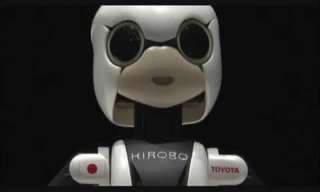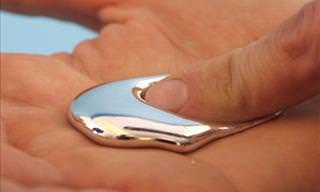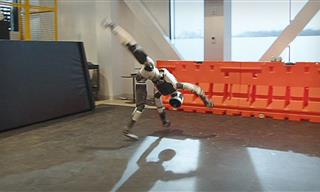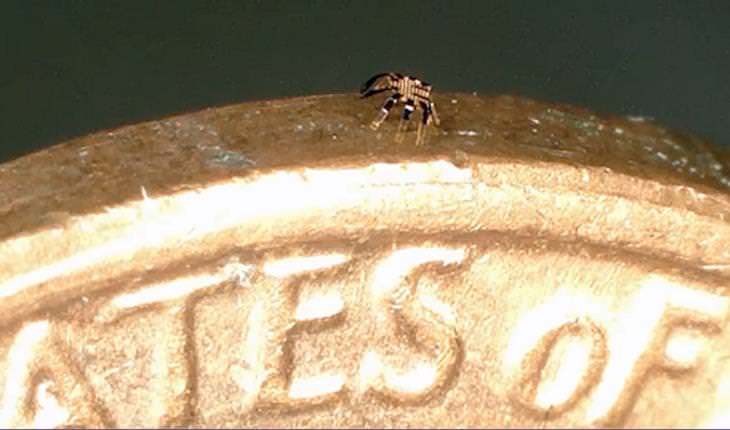
Meet the smallest ever remote-controlled walking robot. It was created by engineers at Northwestern University and resembles a tiny peekytoe crab. This crab is only half a millimeter wide and it can easily be perched on the side of a coin, but it can move and turn in every direction - bending, twisting, crawling, and even leaping. Let’s see what else it can do.
At this time, the study does not have a specific objective. It’s only experimental, but the results are already very promising and can be highly influential in many fields. The researchers propose several possible uses for their crab robot. These include repair or assembly of small structures or surgical assistance in minimally invasive procedures.
This is not the first time this team of engineers breaks records when it comes to robotics. They were also the first to create the smallest ever man-made flying structure. It was a winged microchip smaller than the head of the common ant. The main purpose of the structure is to monitor air pollution, airborne disease, and environmental contamination.
Speed
Seeing as they resemble crabs or tiny creatures, you might imagine that these robots can whizz by pretty fast, but so far, their speed is at an average of half a millimeter a second. While this may sound painfully slow, it is considered a more-than-average speed at such a small scale. You might even be shocked to discover that this robot does not use any electronic or hydraulic machinery to move. Instead, the very material from which it’s made, in combination with remote laser control, is what animates it.
Movement
The researchers used a shape-memory alloy material to build the robot. It transforms to its remembered shape when heated. When it is heated up, it contracts. When it cools down, it expands back to its original shape.
What heats the alloy is a laser beam. The direction of this beam determines the robot's direction of movement. John a. Rogers, Who lead the experimental work, explained that “because these structures are so tiny, the rate of cooling is very fast. In fact, reducing the sizes of these robots allows them to run faster.” As some wise man once said, everything is relative.
How does one come about manufacturing such little things? Well, the researchers at Northwestern will tell you it’s all child’s play. The manufacturing process is inspired by children’s pop-up books, a technique they introduced eight years ago.
First, they create the structures as flat, spread-out sheets. Then they lay these sheets onto a slightly stretched rubber layer. When this stretched rubber is relaxed, all parts are assembled, and the crabs pop into their final three-dimensional forms.
But why a crab of all things? The researchers once again show us their playful side, admitting that this was a creative whim: "With these assembly techniques and materials concepts, we can build walking robots of almost any size or 3D shape, but the students felt inspired and amused by the sideways crawling motions of tiny crabs."
They also created millimeter-sized robots that resemble inchworms, crickets, and beetles. I don’t know about you, but I wouldn’t mind letting this tiny crab join in as an assistant if I ever need surgery. And if you’re not convinced yet, try watching it in action:
 12:14
12:14
Can Migraines Be Cured, Once and For All?
Enjoy these two doctors eloquently explain your headache away.
 11:58
11:58
Myths in Medicine and Health That We MUST Stop Believing
In this video, Dr. Seema Yasmin helps debunk (and confirm) some common myths about medicine and health.
 9:47
9:47
Behind the Scenes of the Human-Like Atlas Robot
In this video, we get a behind-the-scenes look at the development of the incredible Atlas robot.
 14:07
14:07
Can A.I Catch What Doctors Miss? A Fascinating Talk
How close are we to that and can AI really do better than a human doctor? This fascinating TED Talk addresses these issues.

Scientists Develop Ultra White Paint That Could Cool Homes
Scientists developed ultra white paint that reflects 98.1 percent of sunlight. They claim that it can be used as a substitute for air conditioning.

Is Microsoft's "AI Doctor" Better Than a Real Doctor?
A new study presents a committee of digital doctors achieving approximately 80% accuracy in complex medical diagnoses – far beyond the average of general practitioners.

Earth Is So Incredible: I Was Stunned by These 50 Facts
Here's a post that will explain to you just what's truly, scientifically amazing about our planet Earth. I'm gobsmacked.
 5:06
5:06
The Only Manmade Object That Will Last Forever
This copper discus contains 116 images we launched into space for aliens to see
 11:05
11:05
Science: Can AI Preserve Our Most Precious Memories?
Technologist Pau Aleikum Garcia talks about synthetic memories.
 10:31
10:31
Science Predicts These 10 Technologies Will Rule 2025
These upcoming tech innovations will reshape our world.

Let's Learn All About Your White Blood Cells
White blood cells (WBCs) are the part of your immune system which is responsible for fighting infection. Learn all about them here!

The 12 Game-Changing Inventions From 2024 You Missed
2024 was a ground-breaking year in terms of innovation. Here's a look at some of the key breakthroughs from the year.
 11:28
11:28
India Built a Monster Dam That Controls the Weather!
The Polavaram Dam doesn't just control floods - it moves water between regions and much more!
 0:55
0:55
China's G1 Robot is Showing Some Incredible Moves
The G1 is a new robot developed in China and in this video shows some amazing moves.
 58:37
58:37
Science: Here's Everything We Know About Pluto
Join us as we unravel the mysteries of far off Pluto, 3.7 billion miles from our Sun.

8 Ancient Greek Scholars & Their Life-Changing Inventions
The foundations of modern medicine, engineering, biology, and astronomy were set up by these 8 stellar minds more than two thousand years ago.
 42:14
42:14
Physicist Michio Kaku: The Universe in a Nutshell...
Physicist Michio Kaku explains the fundamental nature of our universe
 4:05
4:05
Kirobo: First Robot in Space!
It was one small step for robot and another giant leap for mankind...

6 Harmful Toxins You Didn’t Know You Encounter Daily
These toxic chemicals can be found in everyday products and can be extremely dangerous to us.
 8:19
8:19
You Won't Believe What Passes for a Phone in North Korea
You won't believe what phones look like in North Korea!

12 Earliest Versions of Tech Inventions We Use Every Day
Witness the evolution of 11 popular devices we use all the time by looking at how they all started...
 6:15
6:15
K2-18b: The Exoplanet That Might Host Alien Life
Astronomers have detected signs of posisble life in the atmosphere of exoplanet K2-18b.

10 Fascinating Facts About the Subconscious Mind
10 facts about the way the subconscious mind works

These Materials are Strange Enough to Boggle Your Mind...
There are some materials in this world that totally defy scientific convention. From metals that melt in your hand, to a solid lighter than air, take a look.
 5:14
5:14
Earth 2125: A Vision of the Future of Our Planet
Exploring what Earth could look like in 2125 reveals exciting potential.
 11:02
11:02
Ever Wonder What Ancient Egyptian Sounded Like?
Researchers have used all the information we know to create what they think it may have sounded like.
 1:08
1:08
Boston Dynamics New Robot Can Move Almost Like a Human
Watch the latest in robotics in this video.
 5:50
5:50
The Rise of the Machines: Can Humanoid Robots Help Us?
Will humanoid robots change the way we work forever?
 13:41
13:41
The 5 Most Important Fossil Discoveries from Last Year
2024 saw some really amazing fossil discoveries!
 33:02
33:02
The Entire Story of Earth in 30 Minutes!
The story of our planet, from birth to the adult, ancient planet we see before us today - all in just half an hour.
 9:13
9:13
Want to Travel Quickly Through Space? Try Using a Wormhole
If you want to know what a wormhole is and how it is supposed to work, then you've come to the right place!
 10:59
10:59
Fascinating Science: How Sand is Turned Into Glass
Have you ever looked through a window and wondered how it was made from simple beach sand? This video shows you that incredible process.
 6:47
6:47
7 Exciting Physics Tricks You Have to See!
Watch these seven remarkable physics tricks in this exciting and fun video.
 15:30
15:30
Experts Are Still Baffled by These Ancient Artifacts
These mysterious relics have left experts puzzled.
 50:02
50:02
Take a Trip Through the Universe and Witness its Beauty
Since its launch, the Hubble Telescope returned images of unprecedented beauty of a dynamic and changing universe. Take a look!
 20:04
20:04
Emotions Explained: The Science Behind How We Feel
Neuroscientist and psychologist Dr. Richard J. Davidson answers some fascinating questions about emotions you would never expect.
 2:11
2:11
Here are Some Unique Tricks You Can Do at Home With Salt!
This video shows us a few interesting magic tricks that you can do anytime using salt, ice, and other items you can find at home.

10 Tech Products You Must Double-Check Before Buying
Beware! These tech products are most commonly faked.

What Your Phone Habits Say About Your Mental Health
These phone habits might indicate underlying anxiety—and paying attention to them could help you better understand your mental health.

20 Peculiar Microscope Photos That You Really Must See
An unseen world exists at our fingers, and thanks to these wonderful micrographs, we can get a glimpse into that dimension.
 2:17:01
2:17:01
Astronomy: What is Beyond the Edge of the Universe?
In this video, we explore what modern astronomy reveals about the universe’s boundaries—if they even exist.

Nobody Believed These 5 Scientists, But They Were Right
These 5 scientists were shamed and ousted, or rudely ignored, although years later, their "crazy" theories turned out to be true...
 8:28
8:28
Could These Signals Be A Sign of Extraterrestrial Life?
Scientists have recently picked up on a mysterious radio signal from space, and it could mean a lot - maybe even a sign from extraterrestrial life forms.
 12:34
12:34
The World You See Doesn't Really Exist...
his video reveals how your brain constructs reality instead of simply perceiving it.
 8:12
8:12
The Tallest Statues Compared, Even Those Not Built Yet...
In this 3D animated size comparison, we showcase the tallest statues in the world alongside ambitious future projects.

13 Astonishing Things You Never Thought You'd See
Here are 13 photos of rare phenomena you never thought you'd see!

9 of the Greatest Unsolved Mysteries About the Universe!
The universe has been around for close to 14 billion years, but it still holds many mysteries that continue to perplex scientists. Here's 9 of them!
To enable your Ad-Free Subscription, please fill the fields below
Your subscription was successful, now you can enjoy an ad-free experience!! Note: To make sure you get no ads, please make sure to log in to your account. If you are logged in already, then refresh the page. The subscription can be cancelled at any time.



